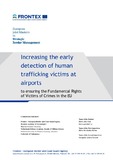| dc.contributor.author | João Guia, Maria | |
| dc.contributor.other | Ramos, Mário Hernández, First Supervisor | |
| dc.contributor.other | Tsourdi, Evangelia (Lilian), Second Supervisor | |
| dc.contributor.other | Frontex – European Border and Coast Guard Agency | |
| dc.date.accessioned | 2020-04-17T06:56:14Z | |
| dc.date.available | 2020-04-17T06:56:14Z | |
| dc.date.issued | 2019 | |
| dc.identifier.uri | https://digiriiul.sisekaitse.ee123456789/2460 | |
| dc.description | 1. General Introduction ; 1.1. Research Questions ; 2. Literature Review ; 2.1. Introduction ; 2.2. Human Trafficking as a global human rights threat ; 2.2.1. Modern practices of human trafficking – new coercion forms in different European Countries ; 2.2.2. Vulnerability concept in the EU ; 2.2.3. Fundamental rights of victims of crimes – evolution and state ; 2.3. Present trends of human trafficking into the EU ; 2.3.1. Introduction ; 2.3.2. Human Trafficking victims: the case of Nigerian Women and Voodoo coercion ; 2.3.3. Children trafficked and concerns on South-American Vulnerabilities (the Brazilian case) ; 2.4. Summary ; 3. Research Methodology ; 3.1. Introduction ; 3.2. The strategy ; 3.2.1. Desk research and analysis ; 3.2.2. Interviews and Focus Groups ; 3.2.3. Case study ; 3.2.4. EU Survey ; 3.2.5. Participant Observation ; 3.2.6. CIRAM Risk Analysis Exercise ; 3.3. Research quality indicators ; 3.4. Ethics ; 4. Analysis and Results ; 4.1. Introduction ; 4.2. Detection of Human Trafficking difficulties ; 4.2.1. Limited time and knowledge ; 4.2.2. Mechanisms to act ; 4.2.3. Sub-conclusion ; 4.3. The VEGA Handbook perception and use ; 4.4. The handbook and standardized procedures ; 4.4.1. Differences in patterns of crimes ; 4.4.2. Sub-conclusion ; 4.5. Children as victims: a group needing urgent intervention ; 4.5.1. Special attention to children ; 4.5.2. Specialized training to identify children being trafficked ; 4.5.3. Unaccompanied children and early detection ; 4.5.4. Sub-conclusion ; 4.6. Women trafficked and voodoo coercion: a new threat in the EU ; 4.6.1. Voodoo detection: hidden coercion ; 4.6.2. Voodoo history ; 4.6.3. Actions to be taken to detect victims of voodoo coercion ; 4.6.4. Sub-conclusion ; 4.7. Organized crime gaining terrain in the EU with human trafficking ; 4.7.1. Organized crime and THB ; 4.7.2. Corruption as a serious consequence ; 4.7.3. Criminality and continuous movement of people ; 4.7.4. Organized crime targeting children ; 4.7.5. Sub-conclusion ; 4.8. Proposals for intervention and improving borders performance at airports ; 4.8.1. Legislation and procedures ; 4.8.2. Technological and new solutions ; 4.8.3. Other possible contributions to improve the early detection ; 4.8.4. The Portuguese case of specialized joint teams at the airport ; 4.8.5. Sub-conclusion ; 4.9. FRONTEX role in the early detection of human trafficking victims’ management ; 4.9.1. Recentering THB question ; 4.9.2. THB Data collection and analysis ; 4.9.3. Training as a central point ; 4.9.4. An example how Risk Analysis could be applied to vulnerability in THB: an exercise on voodoo coercion ; 4.9.5. Sub-conclusions ; 5. Discussion of results, conclusions and Recommendations ; 5.1. Introduction ; 5.2. Conclusions ; 5.2.1. Sub-Question 1 “How difficult is to detect a potential victim of human trafficking at the airports?” ; 5.2.2. How did the VEGA Handbook children at airports (FRONTEX) helped border guards to improve their skills on early detection of vulnerable victims at the airports? ; 5.2.3. Are Member-states and FRONTEX giving the due attention to children potentially being trafficked at the airports? How do they act? ; 5.2.4. Are women being given the due attention, as vulnerable victims, as potentially being coerced through voodoo? How are they recognized/detected as victims at the airports? ; 5.2.5. Is Organized Crime connected to human trafficking crossing airports a real threat to the EU? ; 5.2.6. How can airports border be improved on the early detection of victims of human trafficking? ; 5.2.7. How can the European border management through FRONTEX be effective in early detection of potential victims on crossing-border? ; 5.2.8. How can border police control be more effective in the early detection of vulnerable victims (women and children) of human trafficking at airport controls in order to effectively put in practice the rights of victims of crimes? ; 5.3. Discussion ; 5.4. Limitations of the Study ; 5.5. Recommendations ; 5.6. Further steps in researching this topic | et_EE |
| dc.description.abstract | The reason for studying human trafficking vulnerable victims’ detection at airports was the
concern about 1) the apprehension of economic interests from the organized crime, its potential
corruption deregulation coercing victims; 2) the fundamental rights of vulnerable people
concerns (freedom of choice to live in EU with dignity); 3) the effective protection of the human
trafficking victims’ rights in Member-States.
The objective was to study how mechanisms used at airports in early detection and intervention
with vulnerable human trafficking victims (women and children) work, focusing on improving
proposals. | et_EE |
| dc.language.iso | en_US | et_EE |
| dc.publisher | Frontex | et_EE |
| dc.subject | Euroopa Liit | et_EE |
| dc.subject | lennujaamad | et_EE |
| dc.subject | inimsmugeldamine | et_EE |
| dc.subject | ohvrid | et_EE |
| dc.subject | inimõigused | et_EE |
| dc.subject | kuritegevus | et_EE |
| dc.subject | airports | |
| dc.subject | human smuggling | |
| dc.subject | human rights | |
| dc.subject | crime | |
| dc.subject | victims | |
| dc.title | Increasing the early detection of human trafficking victims at airports to ensuring the Fundamental Rights of Victims of Crimes in the EU | et_EE |
| dc.type | Thesis | et_EE |



